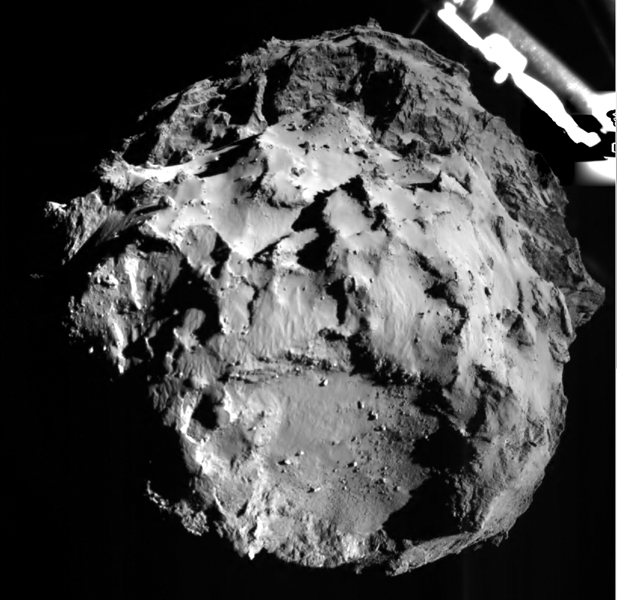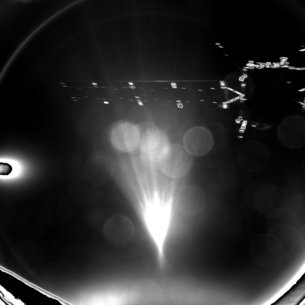Hola amigos: A VUELO DE UN QUINDE EL BLOG., para todos los que compartimos la pasión por los sucesos del Universo, nos sentimos regocijados por un acontecimiento que acaba de suceder con el avance de la tecnología espacial, la Agencia Europea del Espacio ESA, en su misión ROSETTA acaba de poner una sonda llamada Philae sobre el Cometa 67P/Churyumov–Gerasimenko, es un extraordinario avance espacial nunca hecho antes, LEA: LA PÁGINA WEB: http://www.esa.int/esl/ESA_in_your_country/Spain/La_sonda_Philae_de_Rosetta_aterriza_en_el_cometa
La sonda Philae de Rosetta aterriza en el cometa
13 noviembre 2014
La misión de la ESA Rosetta ha aterrizado de forma controlada su sonda Philae en un cometa. Es la primera vez en la historia que se logra una hazaña así.
Después de una tensa espera, durante el descenso de siete horas hacia la superficie del cometa 67P/Churyumov–Gerasimenko, la señal que confirma el aterrizaje exitoso ha llegado a la Tierra a las 16:03 GMT (17:03 CET).
La confirmación se ha enviado vía la nave Rosetta a la Tierra, y ha sido recibida simultáneamente por la estación de la ESA en Malargüe, Argentina, y la estación de la NASA en Madrid. La señal fue confirmada de forma inmediata por el Centro Europeo de Operaciones Espaciales (ESOC) de la ESA en Darmstadt, Alemania, y el Centro de Control de Philae de la agencia DLR en Colonia, Alemania.
Los primeros datos de los instrumentos de la sonda de aterrizaje se transmitieron al Centro de Ciencia, Operaciones y Navegación de Philae en Toulouse, Francia, de la agencia espacial francesa CNES.
“Nuestra ambiciosa misión Rosetta se ha ganado un lugar en los libros de historia. No solo es la primera en entrar en órbita de un cometa; ahora se ha convertido también en la primera en colocar una sonda de aterrizaje en la superficie de un cometa”, dijo Jean-Jacques Dordain, Director General de la ESA.
“Con Rosetta abrimos una puerta al origen del planeta Tierra, y promoviendo una comprensión mejor de nuestro futuro. La ESA y su misión Rosetta han logrado hoy algo extraordinario”.
“Después de más de 10 años viajando a través del espacio, ahora estamos haciendo el mejor análisis científico de uno de los más antiguos remanentes de nuestro Sistema Solar”, dijo Álvaro Giménez, Director de Ciencia y Exploración Robótica de la ESA.
“El éxito de hoy se asienta en décadas de preparación, que garantizan que Rosetta seguirá siendo un actor definitivo en la ciencia de exploración de cometas y espacial”.
“Estamos enormemente aliviados por haber sobrevivido al aterrizaje en la superficie del cometa, especialmente teniendo en cuenta el desafío añadido que ha supuesto los fallos en el estado de la sonda”, dijo Stephan Ulamec, Philae Lander Manager, del DLR, en el Centro Aeroespacial Alemán.
“En las próximas horas sabremos exactamente dónde y cómo hemos aterrizado, y empezaremos a obtener la mayor cantidad posible de datos científicos de la superficie de este mundo fascinante”.
Rosetta fue lanzada el 2 de marzo de 2004 y viajó 6.400 millones de kilómetros a través del Sistema Solar antes de llegar al cometa el 6 de agosto de 2014.
“El viaje de Rosetta ha sido un continuo desafío operacional”, ha dicho Thomas Reiter, ESA Director of Human Spaceflight and Operations. “Ha requerido un abordaje innovador, precisión y mucha experiencia”.
“Este éxito es testimonio del trabajo de equipo sobresaliente y de la experiencia en la operación de satélites, adquirido por la ESA a lo largo de los últimos 50 años”.
El lugar de aterrizaje, bautizado Agilkia y localizado en el corazón del extraño cometa con forma de doble lóbulo, se escogió solo seis semanas antes de la llegada, basándose en imágenes y datos obtenidos desde una distancia de entre 30 y 100 Km del cometa. Estas primeras imágenes revelaron en seguida que el cometa es un mundo lleno de rocas, con acantilados y precipicios, y chorros de gas saliendo de la superficie.
Tras un período en que Rosetta estudió de cerca la superficie, a una distancia de 10 Km, Rosetta se desplazó de nuevo a una trayectoria más alejada para prepararse para soltar a Philae.
La liberación de la sonda se confirmó a las 09:03 GMT (10:03 CET) a una distancia de 22.5 Km del centro del cometa. Durante el descenso de siete horas, realizado sin propulsión ni sistema de guiado, Philae tomó imágenes y recogió información sobre el entorno del cometa.
“Una de las mayores incertidumbres asociadas al envío de Philae fue la posición de Rosetta en el momento de la separación, que ha estado influenciada por la actividad del cometa en ese momento específico y que, a su vez, pudo afectar la trayectoria de descenso de la sonda”, dijo Sylvain Lodiot, ESA Rosetta Spacecraft Operations Manager.
“Más aún, estamos llevando a cabo estas operaciones en un entorno sobre el que apenas hemos empezado a investigar, a 510 millones de kilómetros de distancia de la Tierra”.
Se esperaba tocar la superficie a una velocidad de 1 metro por segundo aproximadamente. El mecanismo de tres patas debe absorber el impacto para prevenir el rebote, y unos crampones en cada pata, y dos arpones disparados en el momento del aterrizaje, deban anclar la sonda a la superficie.
NASA, asín informó:
NASA Statement on Successful Rosetta Comet Landing
The following statement is from John Grunsfeld, astronaut and associate
administrator for NASA’s Science Mission Directorate in Washington, about the
successful comet landing by the European Space Agency’s Rosetta spacecraft:
“We congratulate ESA on their successful landing on a comet today. This
achievement represents a breakthrough moment in the exploration of our solar
system and a milestone for international cooperation. We are proud to be a part
of this historic day and look forward to receiving valuable data from the three
NASA instruments on board Rosetta that will map the comet’s nucleus and examine
it for signs of water.
“The data collected by Rosetta will provide the scientific community, and the
world, with a treasure-trove of data. Small bodies in our solar system like
comets and asteroids help us understand how the solar system formed and provide
opportunities to advance exploration. We look forward to building on Rosetta's
success exploring our solar system through our studies of near earth asteroids
and NASA's upcoming asteroid sample return mission OSIRIS-REx. It’s a great day
for space exploration."
For information about NASA's role in the Rosetta mission, visit:
To learn more about NASA’s asteroid sample return mission, OSIRIS-Rex,
visit:
Surface Impressions of Rosetta’s Comet
Images of comet 67P/Churyumov-Gerasimenko taken on
July 14, 2014, by the OSIRIS imaging system aboard the European Space Agency's
Rosetta spacecraft have allowed scientists to create this three-dimensional
shape model of the nucleus.
Image Credit:
ESA/Rosetta/MPS for OSIRIS
Team/MPS/UPD/LAM/IAA/SSO/INTA/UPM
Feature Link:
Comet 67P/Churyumov-Gerasimenko was imaged by the
European Space Agency's Rosetta spacecraft on July 20, 2014, from a distance of
approximately 3,400 miles (5,500 kilometers). These three images were taken two
hours apart.
Image Credit:
ESA/Rosetta/MPS for OSIRIS
Team/MPS/UPD/LAM/IAA/SSO/INTA/UPM
Feature Link:
Surface structures are becoming visible in new images of comet
67P/Churyumov-Gerasimenko taken by the scientific imaging system OSIRIS onboard
the European Space Agency's Rosetta spacecraft. The resolution of these images
is now 330 feet (100 meters) per pixel. One of the most striking features is
currently found in the comet’s neck region. This part of 67P seems to be
brighter than the rest of the nucleus.
As earlier images had already shown, 67P may consist of two parts:
a smaller head connected to a larger body. The connecting region, the neck, is
proving to be especially intriguing. “The only thing we know for sure at this
point is that this neck region appears brighter compared to the head and body of
the nucleus,” says OSIRIS Principal Investigator Holger Sierks from the Max
Planck Institute for Solar System Research in Germany. This collar-like
appearance could be caused by differences in material or grain size, or could be
a topographical effect.
Even though the images taken from a distance of 3,400 miles (5,500
kilometers) are still not highly resolved, the scientists are remotely reminded
of comet 103P/Hartley, which was visited in a flyby by NASA’s EPOXI mission in
2010. While Hartley’s ends show a rather rough surface, its middle is much
smoother. Scientists believe this waist to be a gravitational low: since it
contains the body’s center of mass, emitted material that cannot leave the
comet’s gravitational field is most likely to be re-deposited there.
Whether this also holds true for 67P’s neck region is still
unclear. Another explanation for the high reflectivity could be a different
surface composition. In coming weeks, the OSIRIS team hopes to analyze the
spectral data of this region obtained with the help of the imaging system’s
filters. These can select several wavelength regions from the reflected light,
allowing scientists to identify the characteristic fingerprints of certain
materials and compositional features.
At the same time, the team is currently modeling the comet’s
three-dimensional shape from the camera data. Such a model can help to get a
better impression of the body’s shape. Rosetta will be the first mission in
history to rendezvous with a comet, escort it as it orbits the sun, and deploy a
lander to its surface.
Rosetta's Philae lander is provided by a consortium led by the
German Aerospace Center, Cologne; Max Planck Institute for Solar System
Research, Gottingen; French National Space Agency, Paris; and the Italian Space
Agency, Rome. The Jet Propulsion Laboratory, a division of the California
Institute of Technology, Pasadena, manages the U.S. participation in the Rosetta
mission for NASA's Science Mission Directorate in Washington. Rosetta carries
three NASA instruments in its 21-instrument payload.
For more information on the U.S. instruments aboard Rosetta,
visit:
More information about Rosetta is available at:
View of Comet from Lander During Descent

This image of comet 67P/Churyumov-Gerasimenko was acquired by the Philae lander of the European Space Agency's Rosetta mission during Philae's descent toward the comet on Nov. 12, 2014. Philae's ROLIS (ROsetta Lander Imaging System) took the image at 14:38:41 UTC (6:38:41 a.m., PST) at a distance of approximately two miles (three kilometers) from the surface. The landing site is imaged with a resolution of about 10 feet (three meters) per pixel.
The ROLIS instrument is a down-looking imager that acquires images during the descent and doubles as a multispectral close-up camera after the landing. The aim of the ROLIS experiment is to study the texture and microstructure of the comet's surface. It was developed by the German Aerospace Center's Institute of Planetary Research, Berlin.
The lander separated from the orbiter at 09:03 UTC (1:03 a.m. PST) for touch down on comet 67P seven hours later.
Rosetta and Philae had been riding through space together for more than 10 years. Philae is the first probe to achieve soft landing on a comet, and Rosetta is the first to rendezvous with a comet and follow it around the sun. The information collected by Philae at one location on the surface will complement that collected by the Rosetta orbiter for the entire comet.
Rosetta is a European Space Agency mission with contributions from its member states and NASA. Rosetta's Philae lander is provided by a consortium led by the German Aerospace Center, Cologne; Max Planck Institute for Solar System Research, Gottingen; French National Space Agency, Paris; and the Italian Space Agency, Rome. NASA's Jet Propulsion Laboratory, a division of the California Institute of Technology, Pasadena, manages the U.S. participation in the Rosetta mission for NASA's Science Mission Directorate in Washington. Rosetta carries three NASA instruments in its 21-instrument payload.
For more information on the U.S. instruments aboard Rosetta, visit http://rosetta.jpl.nasa.gov.
More information about Rosetta is available at http://www.esa.int/rosetta.
Información de NASA y ESA
Guillermo Gonzalo Sánchez Achutegui






No hay comentarios:
Publicar un comentario